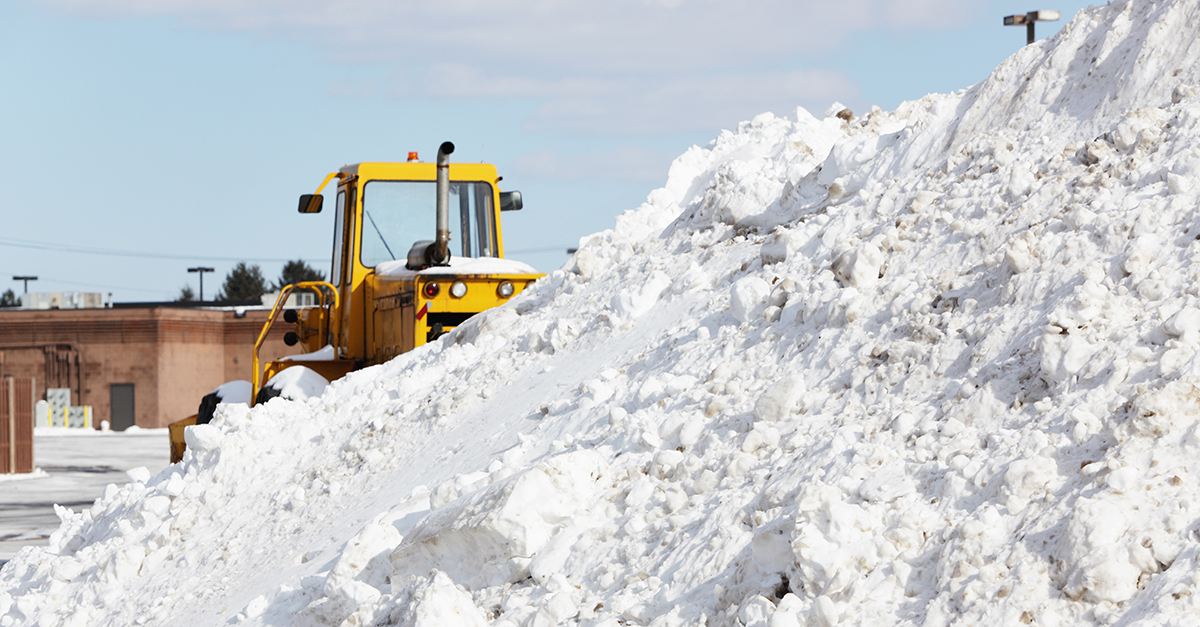Welcome to snow and ice season. This may be a time of the year that pedestrians and commuters dread, but it is also when building service contractors (BSCs) and facility maintenance crews prove their worth.
From schools and hospitals to stores and entertainment venues, facilities rely on contractors and in-house staff to keep parking lots and sidewalks clear of snow and ice so business can go on as usual. Calenthia Torrence-Harper, founder and CEO of City Wide Jani Inc. in Chicago, said her BSC provides snow and ice removal services for various facilities, including offices, residential
buildings, museums, and art centers.
“It’s a lot of work, but once you figure out your strategy and plan, it’s worth it,” she said. “I have never regretted working for myself.” Chris Metcalf is a project manager for grounds with SSC Services for Education, a Knoxville, Tennessee-based company that provides school facilities management.
“I travel all over the country, advising people at K-12 schools, colleges, and universities about grounds upkeep, including snow removal,” he said. “I advise people not only to have a solid plan
for winter weather but to make sure you actually execute the plan [and] then stick to it.”
Set up your plan
One key to success for your winter maintenance plan is to set it up early.
“We start planning for snow and ice removal in August,” Torrence-Harper said. “It may seem early, but it gives us enough time to review equipment, secure contracts, and ensure our team
is fully prepared.”
She explained the early start also gives her time to train new employees and prepare for early snowfalls that might catch others off guard.
“There was one year snow started in October, and I was relieved we were prepared,” she said.
Metcalf starts ordering winter supplies in September. “If you order bulk salt early, you get better pricing,” he said.
An early start also allows Metcalf to update campus snow removal plans, allowing for new construction and demolition that occurs every year. He also uses the time to update his call-in list for contract employees. “I make sure I have an emergency snow removal contractor set up in case we get a blizzard situation that is more than we can handle,” he said. “I like to get contractors on
board early so they commit to working with me.”
About one month before winter, Metcalf sets up a training day to familiarize crews with the equipment and routes, including the fire hydrants and drains they need to clear and the locations to
pile snow so it doesn’t block traffic or pedestrians.
Expect difficulties
No matter how prepared you are, the winter weather always brings challenges.
“Extreme weather conditions such as heavy, wet snow or freezing rain create difficult conditions for the [snow removal] equipment operators,” Metcalf said. “There’s a higher possibility of
accident or property damage.”
“Another challenge is dealing with snowfall during key times for pedestrians and traffic,” he added. “In a perfect world, we would be done with snow removal before rush hour, but it doesn’t
always work out that way.”
Metcalf’s strategy for heavy snowfalls with more than 8 inches predicted is to keep up with the snow removal during the entire duration of the storm, rotating worker schedules so crews are only
plowing a few inches at a time. But when a small amount of snow is expected, he doesn’t see a need to keep crews out overnight. “If it snows at 1 in the morning, there is no reason why you can’t wait,” Metcalf explained. “With smaller snowfalls, we will do snow removal before classes start.”
Torrence-Harper’s approach to snow removal during heavy accumulation depends on the property.
“For retail and public facilities, we remove snow frequently on a rotating basis to keep foot traffic areas clear,” she said. “For residential buildings, we focus on the front of the buildings midway
through the storm to maintain safe access. Once the snow has stopped, we complete the job by cleaning both the front and back. This strategy helps prevent large accumulation, ensures
building residents’ safety, and preserves my workers so they are not overwhelmed trying to remove a large amount of snow at one time.”
Torrence-Harper listed finding workers and keeping those workers safe as her most significant concerns. “One of the biggest challenges is finding reliable people willing to work on an as-needed
basis,” she said. “Snow removal is unpredictable, and not everyone is comfortable working in harsh conditions at odd times.”
Once her workers are in place, another challenge is ensuring they are dressed appropriately for the weather. “Proper attire is crucial for them to work their entire shift without issues, and failing to dress properly can significantly impact their productivity,” she said.
Torrence-Harper stocks up on gloves, socks, and hats for her workers. “If they need, we will provide them with coats and boots as well,” she said. “And it’s important that they stay hydrated, so we drive around and provide water to our workers.”
Choose your equipment and tools
Torrence-Harper and Metcalf rely on a variety of snow and ice removal equipment, choosing the best tools for the weather conditions and the location.
“We use snow blowers, ATVs [all-terrain vehicles] with plows in front, shovels, and ice melt spreaders,” Torrence-Harper said. “Each piece of equipment is tailored to specific tasks. For larger
areas, the ATV with a plow efficiently clears the snow, while snow blowers are ideal for mid-sized paths. Shovels come in handy in tighter spaces where machinery can’t reach. Ice melt spreaders
are essential for ensuring surfaces remain safe from dangerous ice buildup.”
Metcalf said he depends on a truck with a plow or a straight-blade or v-blade plow for streets and parking lots, and snow blowers or shovels for building entries and areas too small for machines.
“When it comes to sidewalks, for lower amounts of snow—under four inches—I like to use a broom attached to a UTV [utility vehicle] or mower,” he explained. “They get right down to the concrete, and it reduces the amount of salt you need. However, once you get a certain amount of snow, you have to use a blade, and brooms won’t work very well with heavy, wet snow.”
To prevent slick surfaces, Metcalf uses a truck with a salt spreader or a drop spreader on the back of a UTV. “I always use treated rock salt [sodium chloride] for parking lots,” he said. “It is more
expensive but contains corrosion inhibitors and is dyed so you can see where you are spreading it. You use less and save money in the long run.”
He avoids rock salt for sidewalks because it can harm turf and bushes. Instead, Metcalf recommends a blended chloride product which is less damaging to grass, landscaping, and concrete.
Working in Chicago, where winter temperatures can be brutal, Torrence-Harper relies on ice melt designed for extreme cold, along with ice picks and torches for especially icy areas. “Don’t skimp
on ice melt—using cheap products can cause more later,” she said. “The ice melt we choose is effective and safe for surfaces, minimizing damage compared to cheaper alternatives that might harm sidewalks or vegetation. Use ice melt that has a visible color so customers can see that their walkways were treated. This adds a level of reassurance and professionalism to your service.”
Both Metcalf and Torrence-Harper stress the importance of pretreatment for ice control.
“I think the biggest mistake people make in preparing for winter storms is neglecting to pretreat walkways and sidewalks,” Torrence-Harper said. “Pretreating creates a barrier that helps prevent ice from bonding to the surface, making removal much easier. Skipping this step allows ice to accumulate, making it more hazardous and harder to remove later.”
Metcalf recommends spraying salt brine, a mixture of salt and water, to pretreat roadways for ice.
“With pretreating, you have the benefit of using less salt,” he said. “I’ve seen parking lots where the snow has melted, and there is salt all over the place, wasting money and damaging the concrete
and asphalt.”
Avoid common snow removal mistakes
In addition to cautioning against waiting until all the snow has fallen to begin removal, Torrence-Harper advised against scheduling services at multiple locations without allowing enough time
between them. She said spreading your crews too thinly to please your clients will eventually backfire.
“Travel times during bad weather can increase dramatically, delaying service and leaving customers waiting longer than expected,” Torrence-Harper said. “It’s better to schedule your crews in one location so they can all hit it before moving on to another customer. If you’re on the north side and have five crews working, keep them clustered close together working in the same general area for favorable results before moving on to your south side customers.”
After the day’s work, inspect all equipment before putting it away to await the next storm. “Regular maintenance prevents breakdowns, which can cause delays and lead to staff burnout from trying to compensate for malfunctioning tools,” Torrence-Harper warned.
“Wash down your equipment after every snowfall to get the salt off it,” Metcalf said. “You can’t see any problems with a hose if it is covered with salt. Check all hoses, fluids, and belts and perform other routine maintenance tasks.”
When moving large amounts of snow, Metcalf cautioned against leaving snow piles in areas that block traffic and motorists’ or pedestrians’ views. “Don’t leave a snow pile right in the middle of the
parking lot,” he said. “Put your piles at the end of the parking lot, in turf areas, or up and over the curb. In some situations, you may not have that option, but you can bring a loader and move the
snow to an area where you don’t have to worry about it as much.”
Go the extra mile
Attention to preparation and documentation will set your services apart from the competition. It’s not enough to know snow is predicted. “Always check and recheck the weather forecast before
snow hits, and if heavy snow hits, do your best to clear paths early so people can move safely,” Torrence-Harper said.
Both she and Metcalf recommend taking pictures to document your finished work in case there’s a slip-and-fall incident on the property you cleared. “It’s very important to keep detailed records of everything you did for each snow event,” Metcalf said. “This type of record keeping comes into play if somebody slips and falls and you have a liability case. Lawyers may contact you two years later, and without records, you won’t remember that snowfall at all.”
Finally, remember you can’t go the extra mile for your clients without doing the same for your employees.
“Pay your staff well,” Torrence-Harper said. “Snow removal is tough work, and well-compensated employees are more likely to remain motivated.”




